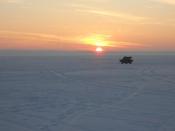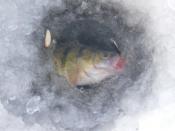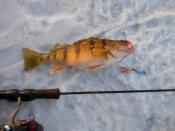 I had the opportunity to take a client Mike out to Mendota for some perch action. It was a rare site to see the lake nearly empty, having the entire basin to ourselves. This does make it a bit more of a challenge to dial in a school of perch amongst Mendota’s 9800+ acres. But applying Mendota’s traditional perch patterns, it didn’t take us long to find a few fish.
I had the opportunity to take a client Mike out to Mendota for some perch action. It was a rare site to see the lake nearly empty, having the entire basin to ourselves. This does make it a bit more of a challenge to dial in a school of perch amongst Mendota’s 9800+ acres. But applying Mendota’s traditional perch patterns, it didn’t take us long to find a few fish.
We targeted an area of 60fow near a transition of mud and hard bottom. By zig-zagging across the 60 fow contour line, we quickly had a depth of 58 fow that the perch were more concentrated in.
 Wanting to get something going quickly, I set us up jigging traditional wire weights, dropper with small rockers, and wax worms and spikes. It was very obvious these fish were negative, and shown very little interest in our offering. By watching the locator, we would see a fish move up to our bait as soon as we dropped it down. Regardless of how still it sat, or how vigorous you shook it, they just looked at it, and faded away.
Wanting to get something going quickly, I set us up jigging traditional wire weights, dropper with small rockers, and wax worms and spikes. It was very obvious these fish were negative, and shown very little interest in our offering. By watching the locator, we would see a fish move up to our bait as soon as we dropped it down. Regardless of how still it sat, or how vigorous you shook it, they just looked at it, and faded away.
 I decided to back-track and check a few holes we previously marked a few fish at on the bottom. To change things up a bit, I took out a jig rod rigged with 2# diameter braid, one of my favorite jigging rapalas, and tipped with a couple smashed up wax worms. It didn’t take very long to get a consistent pattern going. Like our other offerings, as soon as it hit the bottom, a perch would move in to investigate. If you let your bait bounce on the bottom a couple of times, and only lifted it a couple of inches, they would give it a lite tap.
I decided to back-track and check a few holes we previously marked a few fish at on the bottom. To change things up a bit, I took out a jig rod rigged with 2# diameter braid, one of my favorite jigging rapalas, and tipped with a couple smashed up wax worms. It didn’t take very long to get a consistent pattern going. Like our other offerings, as soon as it hit the bottom, a perch would move in to investigate. If you let your bait bounce on the bottom a couple of times, and only lifted it a couple of inches, they would give it a lite tap.
 I quickly set Mike up on a 36″ super-ultralight rod, 2# diameter braid with a 2′ floro-carbon leader, and a jigging spoon tipped with a couple wax worms. It wasn’t the slam fest that I want every client to encounter. But it was steady action throughout the day that iced a couple limits of tasty Mendota perch.
I quickly set Mike up on a 36″ super-ultralight rod, 2# diameter braid with a 2′ floro-carbon leader, and a jigging spoon tipped with a couple wax worms. It wasn’t the slam fest that I want every client to encounter. But it was steady action throughout the day that iced a couple limits of tasty Mendota perch.
On this trip, our key to success was watching the small details. Though the conditions with a bright sunny day would have normally been terrific, we faced some pretty stubborn fish. It was seeing the reaction I could get from them with a bait stirring up the bottom that dialed us into what we needed to offer. Also, success came from not falling into the tradition of smaller baits for negative fish. By just doing something different and that I have confidence in, we managed to piece together a great day.
Also wanted to mention a thanks to Mike that I had out for the day. His “wish list” was short and to the point. “I want to learn how to catch these perch when no one else is getting them”. That’s a tall order on some days, but I appreciated your enthusiasm and open mind to try a variety of techniques. Enjoy your meals of perch, they were well earned!
Nice report Randy.
Very nice report Randy

Congrats on a great day on the ice
Randy:
One of the best rapala colors ever!!!
Mark
Nice perchies .That IS a rare sight,never seen it myself.
.That IS a rare sight,never seen it myself.
Scott, it was really strange to pull into the parking area and only see about 10 cars/trucks parked there…First thought was there was no ice
Great advice on pounding the mud Randy!! Those perch are bursting at the stomache with something?? Do you have freshwater shrimp in that fishery or what do you think they are feeding on??
Gosh I love big Perch!!
Chris – Mendota is an ongoing “project” lake since the late 1800’s. I have had perch puke up shrimp one year, then not see them again for a number of years. These perch that I kept/cleaned had a tiny white larvae that I didn’t know. But from year to year the forage base is continuing to change.
I have not heard any recent news on the impact of the spiny water fleas that were found by a Prof. & a few UW students while casting a plankton net in 2009.
Mendota is a super fertile drainage basin lake that has huge populations of emerald and silver shiners. Cisco had a huge die of in the very early 80’s and hasn’t recovered. Phosphorous since the early 1900’s has fed the abundance of algae.
The fluctuation of water flow (my theory) varies the amount of aquatic life from the Cherokee Marsh and other contributing tributaries into the Madison Chain system. That is why I think the forage base can vary dramatically from year to year. As an example – during floods in the mid 80’s, huge floating bogs broke loose from the marshes and floated into Lake Mendota. The years prior, the water was gin clear and weed-lines as deep as 20fow were very visible. In the year following, what had been lush beautiful weeds beds, were engulfed in duck weed, snot-slime, and other very undesirable aquatic plants. The DNR again began spaying aquacide to control the problem. Now invasive species, changing water quality, and other attributes will have Mendota to continue as an ever-evolving fishery.
Now thats “In Depth” information right there!! Thanks Randy I’m just always curious when I see fat fish what source of protein they bulk up on. Seems if a guy figures out the food source sometimes it makes it easier to pinpoint feeding locations and match baits. Have you tried say White diamond jigs tiped with White Euro’s?? or a White tail??
Short answer this time – I tried the white Finesse Plastics with very minimal success on that day. Later in winter, I’ll try them again when the perch suspend more. Weight is critical as we are fishing 50+ feet down right now or more.
I didn’t know there were perch in Mendota. There is also a rumor of monster channel cats there.
very nice